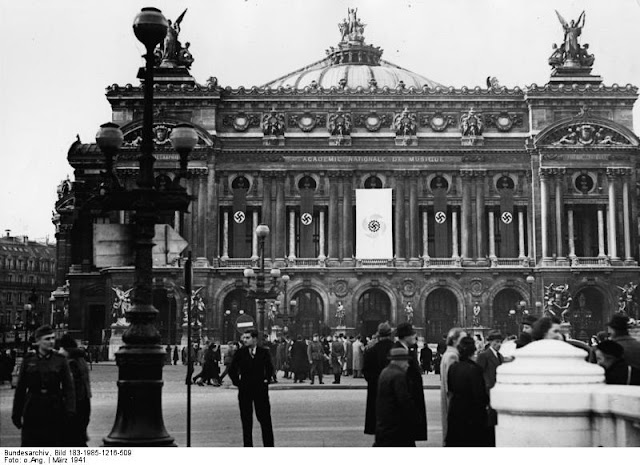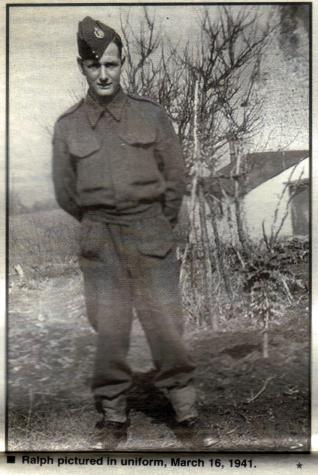Sunday 16 March 1941
 |
| Chilean Reefer goes under. Chilean Reefer is the final victim of the Operation Berlin engagement of 15-16 March 1941 in the Atlantic by German cruisers Gneisenau and Scharnhorst. The photo was taken by the radioman on the Gneisenau (uboatphotos.net). |
 |
| The Paris Opera House, March 1941 (Ang, Federal Archive). |
The rest of the day consists of furious Italian counterattacks to recover the fort that gets nowhere, while renewed British attacks to advance beyond the fort also achieve nothing. The valiant attacks by the Alpini, Bersaglieri, and Grenadiers battalions cost the Italians thousands of casualties that they cannot afford.
At Engiahat, two companies of 4/16 Punjab attack the Italian defenders at 13:00, supported by artillery fire. The attack fails when the Indian troops run out of ammunition. Nearby, the 1st Royal Sussex also fails to make any progress with an attack. Engiahat is very well defended with fortifications. The British now suspend operations on the mountain.
Two battalions of Indian troops leave Aden and land at Berbera in British Somaliland, brought by Royal Navy light cruisers HMS Glasgow and Caledon, destroyers Kandahar and Kingston, and armed boarding vessels Chakdina and Chantala. They capture the port from a 60-man Italian garrison of the 70th Colonial Brigade which is not interested in fighting. They take hundreds of prisoners of Italian support personnel. This is Operation Appearance.
European Air Operations: The Luftwaffe shifts its attention from Glasgow in the north to favored target Bristol in the south. It puts 162 bombers over the city, with the heaviest attacks hitting the center of town and Avonmouth docks. A bomb hits a shelter, causing extensive casualties, and there is great damage throughout the city. An estimated 257 perish and 391 are seriously wounded.
 |
| Clydeside is still assessing the damage from the recent Luftwaffe attacks. These tenements will have to be razed, but much rebuilding will wait until after the war. March 1941. |
U-110 (Kptlt. Fritz-Julius Lemp) is operating south of Iceland and has been shadowing Convoy HX-223. Lemp finally gets into position to attack and torpedoes 6207-ton British tanker Erodana. U-110's torpedo damages the Erodana, but tankers are difficult to sink and the ship gets away (the crew first abandons ship, but it then is towed to Edisvik near Reykjavik). There are 36 deaths.
The tanker's escape is aided by the convoy's escorts, which spot the U-boat on the surface and attack. Lemp escapes the depth charge attack and continues shadowing the convoy. Lemp radios its position to U-boat command (BdU), which vectors in other U-boats.
Meanwhile, Convoys OB 293 and HX 112, heading in opposite directions, are passing each other and essentially have merged for the time being. One of the U-boats that responds to BdU's signal is U-99 (Otto Kretschmer). Arriving well after dark, Kretschmer initiates one of his classic surface attacks from the middle of the convoy at about 22:00. Firing all eight of his remaining torpedoes at the targets all around him, Kretschmer hits six ships and sinks five:
- 8136-ton Norwegian freighter Beduin (sunk, Convoy HX 112, four men perish)
- 6593-ton Norwegian tanker Ferm (sunk, convoy HX 112, everyone survives, the tanker breaks in two and the two halves are later sunk by gunfire)
- 7375-ton Canadian freighter J.B. White (sunk, two dead)
- 6673-ton Swedish freighter Korshamn (sunk, Convoy HX 112, 26 dead)
- 5278-ton British freighter Venetia (sunk, Convoy OB 293, everyone survives)
- 9314-ton British freighter Franche-Comté (damaged, Convoy HX 112, makes it to Rothesay Bay)
U-100 (Kptlt. Joachim Schepke) also answers BdU's call to close on the convoy. Schepke closes on the convoy on the surface from its rear and is almost in a position to attack as the day ends.
German cruisers Gneisenau and Scharnhorst continue their attack on the undefended British convoy they have stumbled upon. At 01:00, the two tankers accompanying the cruisers, Ermland and Uckermark, signal that they have spotted another group of ships headed their way. All the Germans have to do is wait for them. The renewed slaughter begins at dawn:
- 4500-ton British passenger/cargo ship Rio Dorado
- 3648-ton British freighter Empire Industry
- 1577-ton Norwegian passenger/cargo ship Granli
- 4564-ton French passenger/cargo ship Myson
- 4364-ton British passenger/cargo ship Royal Crown
- 1831-ton Danish freighter Chilean Reefer
- 8298-ton Dutch freighter Mangkai (some survivors, become POWs)
- 4347-ton British freighter Silver Fir (one dead, others POWs)
- 5251-ton British freighter Demeterton (entire crew taken as POWs)
- 3491-ton British passenger/cargo ship Sardinian Prince (crew becomes POWs).
German 408-ton patrol boat (former trawler) V-1106 collides with and sinks 2228-ton Norwegian freighter Varangnes in the North Sea off Esbjerg, Denmark.
The Luftwaffe attacks shipping 150 miles southwest of Bloody Foreland. The planes sin 581-ton Royal Navy anti-submarine trawler Lady Lilian and damage 531-ton anti-submarine trawler Angle. The latter makes it to Belfast in tow.
Norwegian 1174-ton freighter Elna E. hits a mine and sinks about 30 km south of Lundy Island. There is one death.
Royal Navy corvette HMS Aubretta collides with 238-ton British trawler Goosander. The corvette is out of action until the end of the first week of April.
German liner Bremen catches fire at Bremerhaven. The ship is ruined and must be scrapped. The ultimate conclusion is that the fire was set by a cabin boy who had been disciplined.
Convoy OB 298 departs from Liverpool.
 |
| A memorial plaque at Tower Hill to some of the crew of the Chilean Reefer, sunk on 16 March 1941 by Gneisenau. |
Royal Navy submarine HMS Parthian (Lt. Commander Rimington) torpedoes and sinks 3141-ton Italian freighter Giovanni Boccaccio near Palmi, Italy.
An Axis convoy departs from Naples bound for Tripoli. There are five troopships/freighters with a heavy escort.
 |
| Pte RF Russell Dorset Regt, 16 March 1941 (Copyright Airborne Forces Archive 2007 by Airborne Forces administrator). |
Spy Stuff: Winston Churchill sends a memo to Permanent Secretary to the Treasury Sir Horace Wilson that Ministers should not be "conversing freely" with the Irish De Valera government. This is because "It must be remembered that the German Legation in Dublin is in close touch with several of the Southern Irish Ministers." In essence, Churchill is accusing the Irish government of being nothing but a nest of spies.
US Military: The US Navy begins escorting convoys bound for Great Britain. The convoys will be met at a midway location and then escorted by the Royal Navy.
German Government: Adolf Hitler gives a major Heldengedenktag (Memorial Day) address at the Zeughaus in Berlin. He asserts that the war was "forced on" Germany by the Allied powers and calls British Prime Minister Winston Churchill "guilty." He accurately states that Germany beat Britain to the invasion of Norway "with just a few hours to spare," and calls the troops that invaded France "defense forces." He concludes that "The German Army is now the strongest military instrument in our history," and that in 1941 it will "end what started the year before."
China: At the continuing Battle of Shanggao, the Chinese are busy building defensive lines. The Japanese 11th Army prepares to attack on the 17th.
Chinese air ace Wong Sun-Sui passes away in a hospital from injuries that he sustained during an aerial engagement two days prior to that above Sumatou District, Chengdu, Sichuan Province, China.
Future History: Charles Herbert Woolery is born in Ashland, Kentucky. After a tour in the US Navy, Woolery joins a musical group called The Bordermen, and also a singing duo called The Avant-Garde. With the latter group, Woolery gets a Top 40 hit with "Naturally Stoned" in 1968. Later, Woolery goes solo, with no success. After an unsuccessful stint acting, Woolery goes back to singing in the country music genre and hits the charts in the late 1970s. Around this time, he begins hosting Wheel of Fortune at the behest of show creator Merv Griffin. After a salary dispute, Woolery effectively is fired and replaced by Pat Sajak. Woolery then hosts a series of other shows and has some personal tragedies. Chuck Woolery remains active in the entertainment industry, and, as of this writing, co-hosts a long-form podcast, "Blunt Force Truth," with Mark Young.
Graziella Granata is born in Rome, Lazio, Italy. In the late 1950s, she becomes an actress in Italian films and Spaghetti Westerns. She is most famous for appearing as the vampire's victim in "Slaughter of the Vampires" (1962). She currently is retired from acting.
 |
| Italian actress Graziella Granata, October 1968 (Italian magazine Radiocorriere). |
March 1, 1941: Rettungsboje
March 2, 1941: Oath of Kufra
March 3, 1941: Germans in Bulgaria
March 4, 1941: Lofoten Islands Raid
March 5, 1941: Cooperation With Japan
March 6, 1941: Battle of Atlantic
March 7, 1941: Prien Goes Under
March 8, 1941: Cafe de Paris
March 9, 1941: Italian Spring Offensive
March 10, 1941: Humanitarian Aid
March 11, 1941: Lend Lease Become Law
March 12, 1941: A New Magna Carta
March 13, 1941: Clydeside Wrecked
March 14, 1941: Leeds Blitz
March 15, 1941: Cruisers Strike!
March 16, 1941: Kretschmer Attacks
March 17, 1941: Happy Time Ends
March 18, 1941: Woolton Pie
March 19, 1941: London Hit Hard
March 20, 1941: Romeo and Juliet
March 21, 1941: Plymouth Blitz
March 22, 1941: Grand Coulee Dam
March 23, 1941: Malta Under Siege
March 24, 1941: Afrika Korps Strikes!
March 25, 1941: Yugoslavia Joins The Party
March 26, 1941: Barchini Esplosivi
March 27, 1941: Belgrade Coup
March 28, 1941: Cape Matapan Battle
March 29, 1941: Lindbergh Rants
March 30, 1941: Commissar Order
March 31, 1941: Cookie Bombs
2020
No comments:
Post a Comment